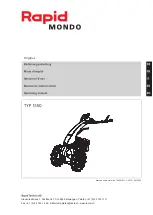
10
Instructions for Use, V2.0, RevG - 07/2016
2. Safety
Warnings - Operating the instrument
The Leica ST5020 may only be operated by trained laboratory personnel, according to its desig-
nated use and per the present Instructions for Use.
In case of emergency switch off mains and unplug the power chord.
While working with reagents (filling / emptying the reagent stations, working on the instrument
while the lid/s is/are open) appropriate protective gear (lab coat, gloves, safety goggles) must
be worn.
Make sure to operate the instrument either with the activated carbon filter or with the exhaust
air hose. Even when the instrument is operated according to its designated use, hazardous sol-
vent fumes develop, which are damaging to the operator's health and do also pose a risk of fire!
Risk of fire, when working with an open flame (Bunsen burner) immediately next to the instru-
ment (solvent fumes)! - Therefore, keep a safety distance of 2 meters!
If a staining program is to be interrupted for an extended period of time, do not leave any slide
racks in the tap water stations, in order to prevent them from drying out.
Warnings - Cleaning and maintenance
Prior to each maintenance and/or cleaning, switch the instrument off and disconnect mains
power. Do not clean the instrument with solvents containing acetone or xylene. No liquid may
be spilled into the internal components of the instrument - neither during operation nor during
cleaning.
When working with cleaning detergents, comply with all safety instructions by the manufac-
turer of the product and the laboratory management policy.
Wash the tap water and reagent stations in the dishwasher at a temperature of max. +65 °C
(149 °F). Use a standard detergent for laboratory dishwashers.
At any rate avoid washing the stations at higher temperatures, as the stations may become de-
formed!
Spilled solvents (reagents) have to be wiped away immediately! - In case of long-term expo-
sure, the lid surfaces are only conditionally resistant to solvents!
To clean the lids, control panel and housing, use mild household detergents; - see safety in-
struction above for non-appropriate ingredients!
Caution with sequences which involve an oven at the initial step.
In this case the loading unit, out of which the specimen holder is removed via the transport arm,
must NOT be filled with an inflammable reagent (e.g. xylene).
As the oven temperature is up to 80 °C (176 °F), the reagent may ignite and cause damage to the
device and to the samples.
For the same reason, steps conducted INSIDE an oven must never be carried out from a reagent
station with inflammable reagents.











































